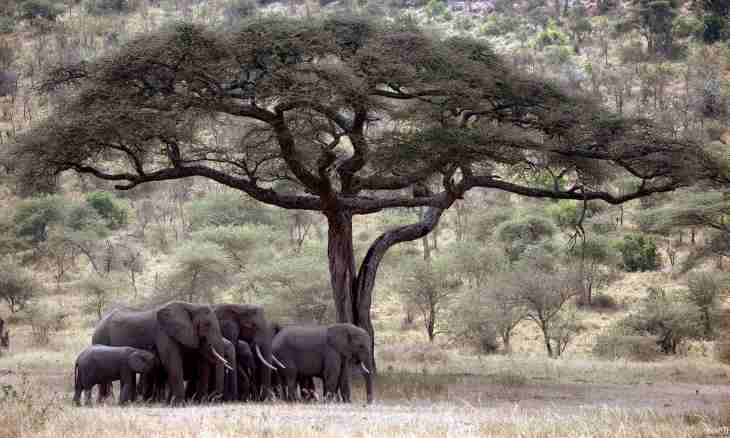The word "savanna" came from English "saban" and means the treeless area or simply the steppe. Savannas are located on both sides of the equator in territories of Africa, South America, Australia and are characterized by change of the dry and rainy periods. In different parts of the world this area is called differently. In Australia - "буш", in South America – Pampas. But typical "park" savannas are located in Africa in territories of Tanzania, Kenya, Ghana, Mali, South Sudan, Zambia, Angola. The fauna of the savanna is unique. Here more animals, than anywhere live.
Instruction
1. In the world there is no such quantity large herbivorous, as in the African savanna anywhere. Huge herds of hoofed animals – zebras, gazelles, antelopes, buffalo s – constantly wander from place to place "after a rain", in large quantities eating and treading grassy vegetation. Considerable number herbivorous and their constants and seasonal migrations promote preservation of a typical "park" view of the African savanna.
2. The largest inhabitant of savannas is the African elephant. Its growth reaches 4 m, and weight is measured by dozens of tons. Being a herbivore, the elephant is perfectly adapted for life in a shroud. The trunk allows it to reach the top branches of the plants inaccessible for others herbivorous, and works as the pump during a watering place and bathing.
3. One more typical representative of savannas – a giraffe, the highest animal on the planet. A giraffe – herbivorous hoofed, living only to Africa. Its growth reaches 6 m, and the tone nearly a ton weighs. Without watching the very significant growth and weight the giraffe is capable to gather speed to 60 km/h. But usually he is slow, runs only at emergence of danger.
4. A black and white rhinoceros - typical representatives of the African savanna. Now meet rather seldom. The number of rhinoceroses was strongly reduced because of shooting by their poachers.
5. Herds herbivorous always accompany predators. Here 2 species of lions – berberiysky and Senegalese live. The first – to the north of the equator, the second – to the south. One more representative of predators – a cheetah - the fastest animal of the planet. In the course of prosecution the cheetah is capable to gather speed to 110 km/h. Except lions and cheetahs it is enough also other predators here - sectional cats or servala, hyenas, jackals, giyenovy dogs.
6. The great number of birds lives in the African savannas. A considerable part of birds is flying, and periodically appear as a result of the year migrations here. The primordial representative of the savanna - the African ostrich – the largest representative from all recent birds. The ostrich is the bird who is not flying. Its growth reaches 250 cm, and the weight of 150 kg. At run it gather speed to 70 km/h, and it is capable without reducing speed, to sharply change the direction of run.
7. Small birds - bustards, plovers, larks, hazel grouses, skates, starlings, tkachik, turtle-doves, pigeons, halcyons, birds rhinoceroses, etc. are numerous. The rain stork nests in crowns. It is a lot of birds of prey – a buzzard, a bird the secretary, a black-winged kite, an eagle buffoon, the African kestrel, a marsh owl, five types of the signature stamps arriving on a wintering from Europe. There are also deathbirds which typical representatives are a marabou stork and the African signature stamps. The second serve as hospital attendants as eat only drop in a shroud.
8. Klyuvoka – the small, olive-brown krasnoklyuvy birds who are constantly accompanying large herbivorous – buffalo s, elephants, rhinoceroses are interesting. These birds eat, the ticks and other parasites getting into folds of skin of large animals.
9. During a dry season the great number of birds nests on sandy shallows and steep coast of the rivers and lakes – lapwings, water cuts, sandpipers, morwennols, ibises, yakana, ducks, geese, cormorants, herons, pelicans. In the most part of territories pink flamingos are widespread.
10. The largest representatives of the reptiles living here is the crocodile and a predatory Nile monitor lizard reaching in length of 2 m. The most impressive representative of reptiles - the iyeroglifovy python reaching six-meter length.
11. One of characteristic details of a landscape African shrouds are termitaries as termites are presented by dozens of types here. They are the main consumers of any vegetable remains. Having remembered termites, it is necessary to remember one more inhabitant African shrouds. An anteater or trubkozub – the animal of the average sizes having the extended muzzle and the powerful claws allowing it to dig out termitaries. Eats trubkozub ants and termites.
